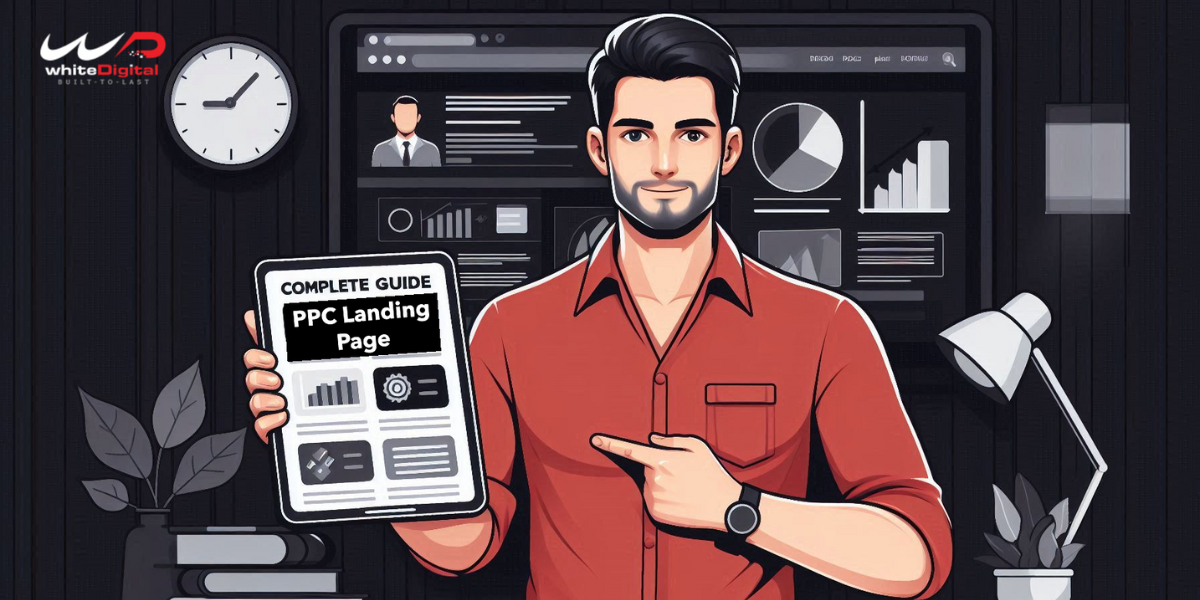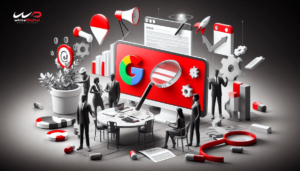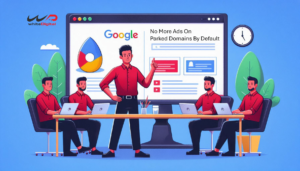Having good PPC landing pages enhances the overall experience and makes your campaign more effective.
Your ad clicks won’t work out if you don’t have an optimized PPC landing page.
In this guide, we’ll take you through everything you need to be aware of in the PPC landing page systems.
Starting from key design elements of your PPC landing pages to best practices for improving user experience and boosting conversion rates everything will be covered.
It doesn’t matter whether you’re new to pay-per-click or just want to enhance your strategy this guide will work as a roadmap to help you create landing pages that maximize the return on your ad spend.
Table of content
- What is a PPC Landing Page?
- What are the benefits of PPC landing pages?
- What is the difference between a PPC landing page and a webpage?
- PPC Landing Page Best Practices
- Key Considerations When Creating a PPC Landing Page for Google Ads
- FAQs
What is a PPC Landing Page?
The pay-per-click landing page is a specific web page created to convert traffic that we get from paid ads. It’s a system we use to convert traffic to leads and sales.
Unlike regular web pages, the main goal behind the PPC landing page is to lead the visitor to a specific action like making a purchase, subscribing to a newsletter or requesting more information on the page.
The main purpose behind landing pages is conversion from visitor to customer. These landing pages are specially optimized for conversions and are linked to the ads we run on platforms like Google Ads, Bing Ads, and other social media networks.
Instead of a regular homepage visit, the click on ads are taken down to a specific landing page to give a more customized and targeted experience to the user.
What are the benefits of PPC landing pages?
1. Increased Conversion Rates
Driving visitors to take action is the most important and fundamental task of landing pages. The action can be anything from filling out a form to making a purchase but driving an action is the main element that goes behind landing pages.
The general web pages serve multiple purposes but the PPC landing page on the other hand is created with the sole purpose of minimizing distractions by eliminating unnecessary links and content and driving users to an action.
The approach behind the PPC landing page is to guide visitors towards completing a desired action which ultimately gives higher conversion rates. By concentrating on specific action PPC landing pages streamline the user journey.
2. Improved Ad Relevance
One of the key factors in determining your ad’s performance, especially on platforms like Google Ads, is its relevance to the landing page. By creating a landing page that closely aligns with your ad content—both in messaging and offer—you can significantly improve your Quality Score.
A higher Quality Score can lead to lower cost-per-click (CPC) rates and better ad placements, meaning you get more value for your advertising budget. The more closely your landing page matches the keywords and promises in your ad, the more likely it is to meet both platform and user expectations, enhancing overall campaign effectiveness.
3. Better User Experience
Visitors who click on a PPC ad are typically looking for something specific, whether it’s information, a product, or a service. PPC landing pages ensure that users find exactly what they’re expecting when they arrive. Instead of navigating through a complex or cluttered homepage, visitors are taken directly to a page that addresses their immediate needs.
This clear and simple pathway provides a better user experience by reducing friction and confusion, which in turn encourages users to stay on the page longer and complete the desired action. A smooth, user-friendly journey is crucial to converting visitors into customers.
4. Targeted Messaging
PPC landing pages allow advertisers to tailor messaging for specific audiences or ad groups. For instance, if you are running ads for multiple audience segments or offering different products, each segment or offer can have its own landing page. This allows for personalized content that resonates with the specific needs and interests of that group.
Targeted messaging improves relevance and engagement, as users feel that the content speaks directly to them. This level of specificity increases the likelihood of conversion because the message is aligned with the user’s expectations and search intent.
5. Easier A/B Testing
Since PPC landing pages are typically focused on a single action, they are perfect for A/B testing different elements to find what works best. You can test various aspects, such as headlines, call-to-action (CTA) buttons, images, and even the overall layout. By analyzing how different versions perform, you can optimize your landing pages over time to improve conversion rates.
A/B testing helps marketers continuously refine and enhance their landing pages, ensuring better performance and higher returns from their PPC campaigns. This iterative process allows for data-driven decisions, making improvements measurable and actionable.
6. Improved ROI
By focusing on a conversion-oriented design and clear messaging, PPC landing pages can deliver a significantly higher return on investment (ROI) for your ad spend. A well-crafted landing page converts visitors into customers, which means your ad dollars are more effectively spent. When users are met with a landing page that directly fulfils the promise of the ad, they are more likely to convert, increasing the efficiency of your campaigns.
A high-converting landing page reduces the cost per acquisition, allowing businesses to generate more revenue from the same or even lower ad budgets.
7. Data Collection
Many PPC landing pages feature forms that collect valuable information, such as names, email addresses, and phone numbers. This data can be crucial for businesses looking to build a customer database or nurture leads for future marketing efforts. The landing page serves as the entry point for gathering leads and starting relationships with potential customers.
The collected data not only aids in immediate conversions but also enables businesses to execute follow-up strategies through email marketing, retargeting, or personalized offers, turning one-time visitors into long-term customers. By capturing this data, businesses can create a continuous feedback loop for optimizing future marketing campaigns.
What is the difference between a PPC landing page and a webpage?

PPC Landing Page Best Practices
1. Keep it simple: Avoid cluttering your page with unnecessary information or design elements.
2. Use compelling copy: Write persuasive, benefit-focused copy that addresses the visitor’s pain points and offers solutions.
3. Implement a logical flow: Structure your content in a way that naturally leads visitors towards your CTA.
4. Use white space effectively: Proper use of white space can improve readability and guide the user’s attention to important elements.
5. Optimize form length: If using a form, only ask for essential information to reduce friction in the conversion process.
6. Implement security measures: Display security badges and use HTTPS to build trust, especially if collecting sensitive information.
7. Create a sense of urgency: Use limited-time offers or scarcity tactics to encourage immediate action.
8. Ensure message match: Maintain consistency in messaging from your ad to your landing page to meet visitor expectations.
9. Use directional cues: Employ visual cues like arrows or images of people looking towards your CTA to guide visitor attention.
10. Provide multiple contact options: Offer various ways for visitors to get in touch, catering to different preferences.
Key Considerations When Creating a PPC Landing Page for Google Ads
1. Quality Score optimization
Focus on relevance, landing page experience, and expected click-through rate to improve your Quality Score.
2. Keyword relevance
Ensure your landing page content includes relevant keywords from your ad groups.
3. Load time
Optimize images and code to ensure fast loading times, as this is a factor in Google’s Quality Score.
4. Mobile optimization
With Google’s mobile-first indexing, ensuring a great mobile experience is crucial.
5. Ad extensions utilization
Take advantage of ad extensions to provide additional information and improve click-through rates.
6. Conversion tracking
Implement Google Ads conversion tracking to measure the effectiveness of your landing pages.
7. Compliance with policies
Ensure your landing page complies with Google Ads policies to avoid disapprovals or account suspensions.
8. Dynamic text replacement
Use dynamic keyword insertion on your landing pages to increase relevance for different search queries.
9. Geotargeting consideration
If running local campaigns, ensure your landing page content is relevant to the targeted geographic area.
10. Regular updates
Keep your landing page content fresh and updated to maintain relevance and quality.
FAQs on the PPC landing Page
1. What is a PPC landing page?
A PPC landing page is a separate web page designed to receive traffic from pay-per-click advertising campaigns. Its primary purpose is to convert visitors into leads.
2. Why can’t I just direct people to my client’s website rather than a PPC landing page?
Using a PPC landing page ensures focused messaging, higher conversion rates, and improved tracking. It reduces distractions, enhances user experience and aligns with ad campaigns for better results.
3. What are the key components of a PPC landing page?
Key components of a PPC landing page include a compelling headline, clear CTA, relevant visuals, concise copy, social proof, lead capture form, mobile responsiveness, and minimal distractions for effective conversions.
4. Can every industry use a PPC landing page?
Yes, virtually every industry can utilize PPC landing pages, as they effectively target specific audiences, promote products or services, and drive conversions, regardless of the market.
5. What are some common goals of a PPC landing page?
Lead generation, sales conversion, sign-ups, event registration, downloads, app installs, information gathering, and increasing brand awareness to optimize user engagement are some of the common goals of a PPC landing page.
6. Is it important to add customer testimonials to a PPC landing page?
Yes, it is important to add customer reviews as this page will be viewed by the users and decide whether to convert or not.
7. How does a PPC landing page work with Google Ads?
PPC landing pages work with Google Ads by providing a relevant destination for ad clicks, enhancing user experience, improving Quality Scores, and ultimately driving higher conversion rates from targeted traffic.
Wrap-up
In short, now you would have known that a well-optimized PPC landing page is essential for increasing the effectiveness of PPC advertising campaigns. By creating a focused, user-friendly experience that aligns with the ad’s messaging, businesses can significantly increase conversion rates and drive valuable traffic to their sites.
Understanding the key elements such as persuasive headlines, strong calls to action, and relevant content enables marketers to get hold of the attention of potential customers and guide them towards making informed decisions.
Finally, investing time and resources into developing an effective PPC landing page can lead to higher returns on advertising spend and contribute to long-term business growth.
Now you know why is it important to create and maintain a PPC landing page. If you are not sure where to start, feel free to contact us.













